TOC男の子の節句・こどもの日 / Boy’s Festival & Children’s Day
5月5日は「こどもの日」です。昔は「端午の節句(たんごのせっく)」と呼ばれ、男の子の健康と成長を願う日として祝われてきました。
今では、男女問わず「こどもの日」として祝われていますが、鯉のぼりや五月人形など、男の子の成長を願う飾りが多く見られます。
May 5th is “Children’s Day” in Japan. Traditionally, it was called Tango no Sekku and celebrated as a festival to wish for the healthy growth of boys.
Nowadays, it’s a national holiday to celebrate all children, but you’ll still see traditional decorations like Koinobori (carp streamers) and samurai dolls, especially for boys.
鯉のぼり / Koinobori (Carp Streamers)
鯉のぼりは、鯉が滝を登って龍になるという中国の伝説に由来しています。
強く、元気に育ってほしいという願いを込めて、家の外に鯉の形の旗を飾ります。
黒い鯉が「お父さん」、赤が「お母さん」、その下に青や緑の小さい鯉が「子どもたち」を表しています。
Koinobori are carp-shaped streamers that come from a Chinese legend about a carp that swam up a waterfall and became a dragon.
They symbolize strength and determination, and families hang them outside to wish for their children’s healthy growth.
The black carp represents the father, the red one the mother, and the smaller ones below represent the children.
Sign up here for “Rakuten Global Express”!
Worldwide Shipping Available!
Get Authentic Made-in-Japan Products!
English Support Available!
Sign up here for “Rakuten Global Express”!
|
|
うちの鯉のぼりの飾り方|How We Set Up Our Koinobori (Carp Streamers)
うちでは、毎年こどもの日に合わせて、古くから使っている鯉のぼりを飾っています。
We put up our traditional koinobori (carp streamers) every year for Children’s Day.
quick movie📽️
copy_00447DFA-E8C2-4DDE-A5E5-C3FCA878CDDF
手順はこんな感じです:
Here’s how we set it up:
① 支柱を組み立てる|Set up the pole
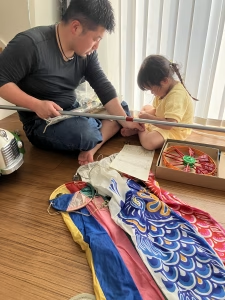
まずは、鯉のぼりを立てるための支柱(ポール)をしっかりと組み立てます。
First, we build the pole that holds up the koinobori.
② 矢車を支柱に付ける|Attach the weather vane
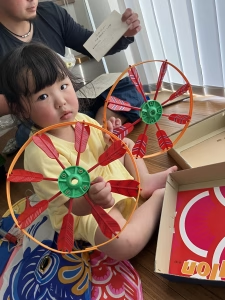
次に、風でクルクル回る矢車(やぐるま)をポールのてっぺんに取り付けます。
Next, we attach the spinning yaguruma (weather vane) to the top of the pole.
③ 回転球を付ける|Add the rotating ball
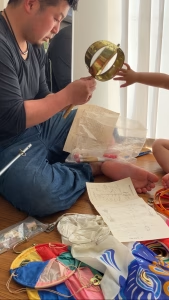
その下に、飾り用の回転球をセットします。これも風でくるくる回ります。
Below that, we add the kaiten-kyuu (rotating ball), which also spins in the wind.
④ 吹き流し→真鯉→緋鯉→子鯉の順で紐に通す|Thread the streamers and carps in order
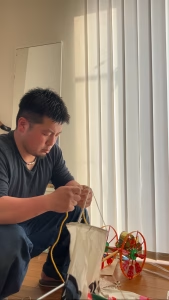
順番に紐へ通していきます:吹き流し(風を受ける帯)→真鯉(黒)→緋鯉(赤)→子鯉(小さなカラフルな鯉)。
We thread them in this order: Fukinagashi (colorful streamer) → Magoi (black carp) → Higoi (red carp) → Kogoi (small colorful carps).
⑤ 紐を支柱にくくりつけて完成!|Tie the string to the pole and it’s done!
最後に、全部通した紐を支柱にくくりつけたら、完成です!風に泳ぐ鯉のぼりを見ると、毎年ほっこりします。
Finally, we tie the string to the pole and it’s all done! Watching the carps swim in the wind always brings us joy every year.
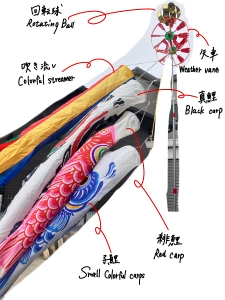
鯉のぼりの色の意味|What the Colors of Koinobori Mean
鯉のぼりには、それぞれの色に意味があります。家族を表すシンボルとして、色ごとに役割があるんです。
Each koinobori (carp streamer) color has its own meaning. The different colors represent members of the family.
真鯉(黒)|Magoi (Black Carp)

→ お父さんを表しています。力強く、大きな黒い鯉です。
→ Represents the father. It’s the biggest and strongest black carp.
緋鯉(赤)|Higoi (Red Carp)

→ お母さんを表します。やさしさや愛情の象徴です。
→ Represents the mother. It symbolizes love and kindness.
子鯉(青・緑・オレンジなど)|Kogoi (Blue/Green/Other Colors)
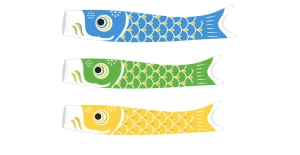
→ 子どもたちを表します。色は家庭によっていろいろ!
→ Represents the children. The colors vary—blue, green, orange, etc., depending on the family.
吹き流し|Fukinagashi (Streamer)

→ 鯉のぼりの一番上に付けるカラフルな布。邪気を払う意味があります。
→ The colorful streamer at the very top. It’s meant to ward off evil spirits.
もともとは「黒い鯉(真鯉)」しかなかったけど、だんだん家族全員を表すように増えていったんだって!
Originally, only the black magoi was used. Over time, more colors were added to represent the whole family!
|
|
兜飾り(Kabuto Decoration)について
兜飾り(かぶとかざり)は、5月5日の「こどもの日」に男の子の成長と健康を願って飾る伝統的な装飾です。兜(かぶと)は、昔の武士がかぶっていたかぶと(ヘルメット)のことで、強さや勇気の象徴とされています。
もともとは「端午の節句(たんごのせっく)」と呼ばれる男の子のための行事で、鎧兜(よろいかぶと)や五月人形(ごがつにんぎょう)を飾る習慣がありました。最近では、スペースの都合で小さめの兜飾りを飾る家庭も多くなっています。
現代では、かっこいいデザインのものや、コンパクトでおしゃれな兜飾りもあり、インテリアとしても楽しめます。子どもに「強くたくましく育ってほしい」という願いが込められています。
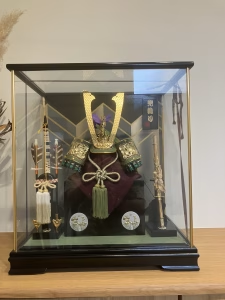
The Kabuto Decoration is a traditional Japanese ornament displayed on May 5th, known as Children’s Day. It is especially for boys, wishing for their healthy growth and strength. The word kabuto refers to the helmet worn by samurai warriors in the past, symbolizing courage and protection.
Originally, this celebration was called Tango no Sekku, a festival for boys, where families would display warrior armor (yoroi kabuto) and samurai dolls (Gogatsu Ningyo). These days, many families prefer smaller, modern kabuto decorations due to space and lifestyle.
Today’s kabuto decorations come in cool, stylish designs and are often used as interior decor. They represent a family’s hope that their children will grow up brave and strong.Go
気になる「Japanese Mama」のおすすめ商品があったら…
See something you like from Japanese Mama’s blog?
まずは「楽天グローバルエクスプレス」に登録!
ブログで紹介しているショップから、
あなたの国まで簡単にお届けできます!
Just sign up for Rakuten Global Express first,
and you can easily order products featured on the blog—
shipped straight to your country!
Kashiwa Mochi: A Traditional Treat for Children’s Day
柏餅(かしわもち)– こどもの日の伝統的なお菓子
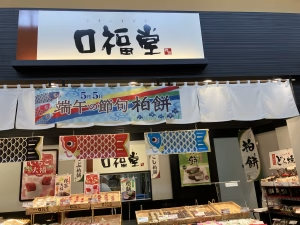
On May 5th, Japan celebrates Children’s Day (Kodomo no Hi), a national holiday to wish for the healthy growth and happiness of children.
日本では5月5日を「こどもの日」として、子どもたちの健やかな成長と幸せを願う日としています。
One of the traditional sweets eaten on this day is Kashiwa Mochi, a soft rice cake filled with sweet bean paste and wrapped in a kashiwa (oak) leaf.
この日に食べる伝統的なお菓子の一つが「柏餅(かしわもち)」です。あんこ入りのお餅を、柏の葉で包んだ和菓子です。
The oak leaf is not edible, but it plays an important symbolic role.
柏の葉は食べられませんが、大切な意味が込められています。
Because oak leaves do not fall off until new leaves grow, they are seen as a symbol of family continuity and prosperity.
柏の葉は新芽が出るまで古い葉が落ちないことから、「家系が絶えない」「子孫繁栄」の象徴とされています。
Eating Kashiwa Mochi on Children’s Day reflects the hope for children to grow up strong and for families to continue for generations.
こどもの日に柏餅を食べるのは、子どもたちが元気に育ち、家族が代々続いていくよう願う気持ちの表れです。
In eastern Japan, Kashiwa Mochi is the standard treat for this holiday, while in western regions, chimaki (sweet rice wrapped in bamboo leaves) is also common.
東日本では柏餅が一般的ですが、西日本では笹の葉で包んだ「ちまき」もよく食べられています。
There are various types of Kashiwa Mochi, including koshi-an (smooth red bean paste), tsubu-an (chunky red bean paste), and miso-an (white miso-flavored paste).
柏餅にはいろいろな種類があり、「こしあん」「つぶあん」「みそあん」など、地域や家庭によって異なります。
Why not enjoy this delicious and meaningful sweet while celebrating Children’s Day with your loved ones?
こどもの日には、ぜひ大切な人と一緒に、このおいしくて縁起の良いお菓子を楽しんでみてはいかがでしょうか?
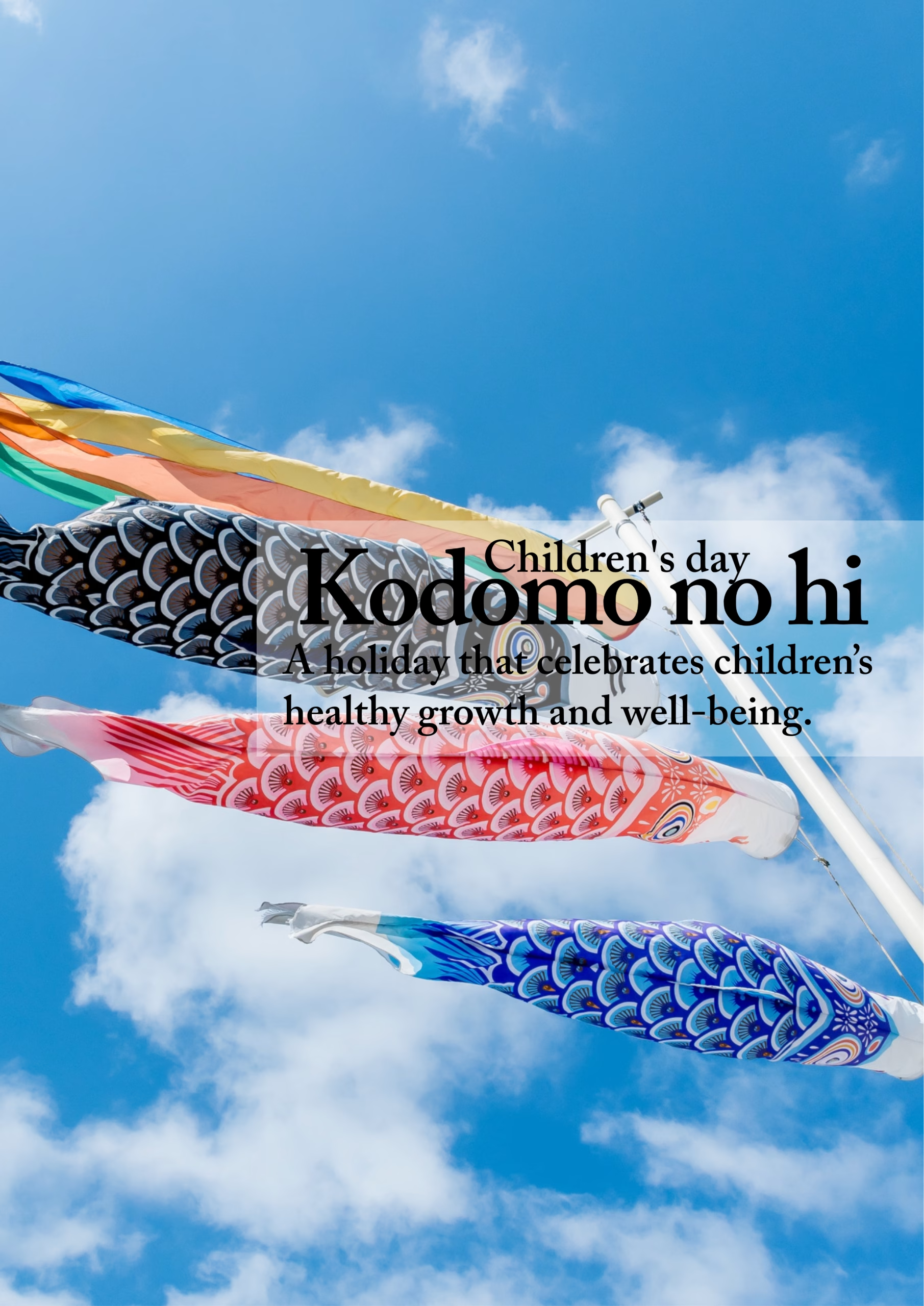
![[商品価格に関しましては、リンクが作成された時点と現時点で情報が変更されている場合がございます。] [商品価格に関しましては、リンクが作成された時点と現時点で情報が変更されている場合がございます。]](https://hbb.afl.rakuten.co.jp/hgb/47ad4a69.85f59398.47ad4a6a.0aa75bda/?me_id=1247445&item_id=10005510&pc=https%3A%2F%2Fimage.rakuten.co.jp%2Fyuinouya-chouseidou%2Fcabinet%2Fimgz5%2F406i-1.jpg%3F_ex%3D240x240&s=240x240&t=picttext)

![[商品価格に関しましては、リンクが作成された時点と現時点で情報が変更されている場合がございます。] [商品価格に関しましては、リンクが作成された時点と現時点で情報が変更されている場合がございます。]](https://hbb.afl.rakuten.co.jp/hgb/47ad4bde.21a45211.47ad4bdf.bffe278f/?me_id=1382652&item_id=10014545&pc=https%3A%2F%2Fthumbnail.image.rakuten.co.jp%2F%400_mall%2Fworld-free-store%2Fcabinet%2F07084073%2F09998566%2Fimgrc0091058424.jpg%3F_ex%3D240x240&s=240x240&t=picttext)
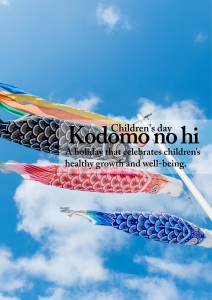

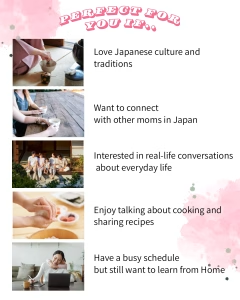
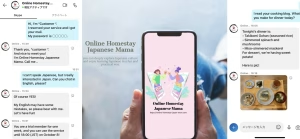
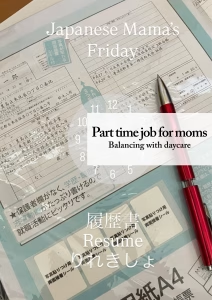

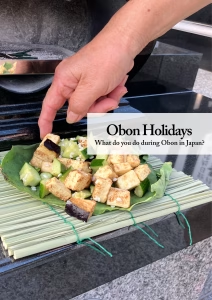

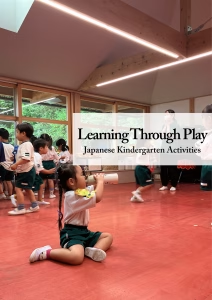



Comments